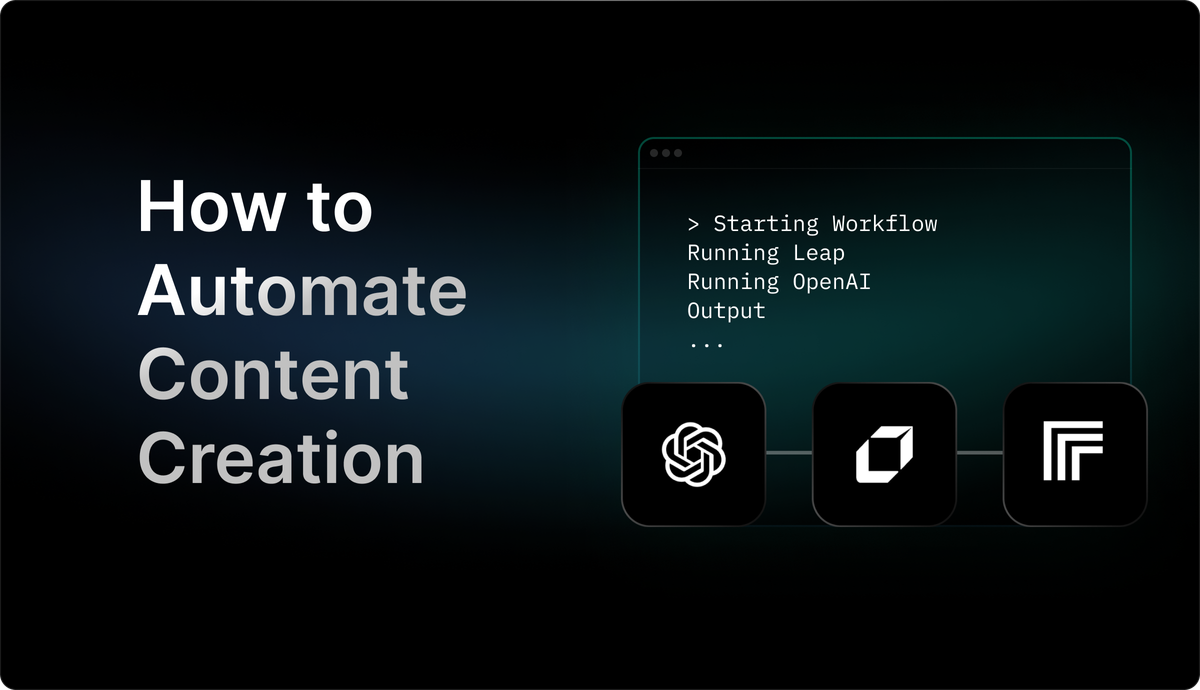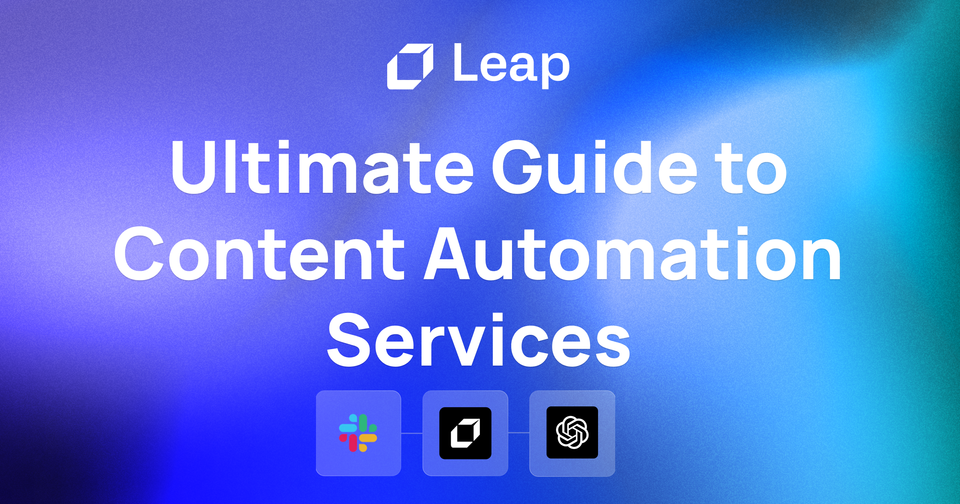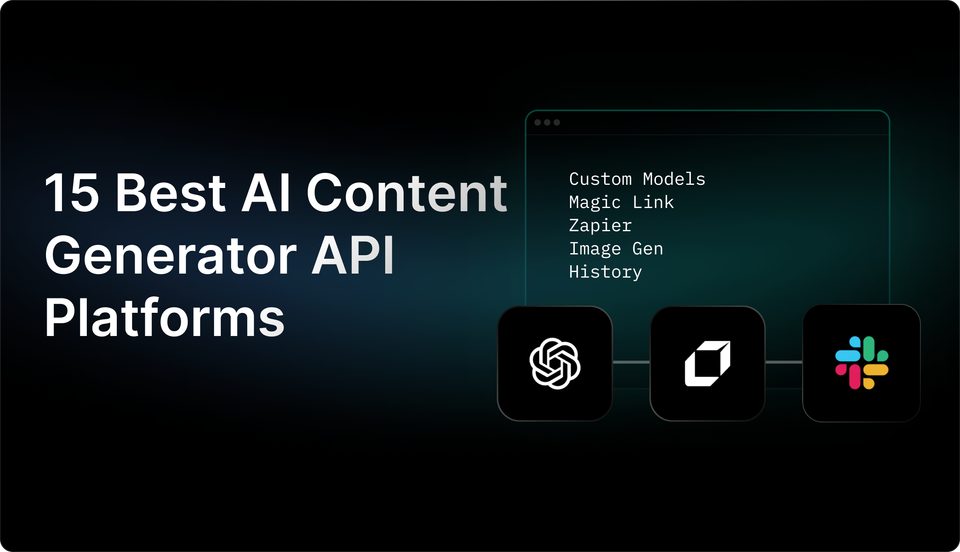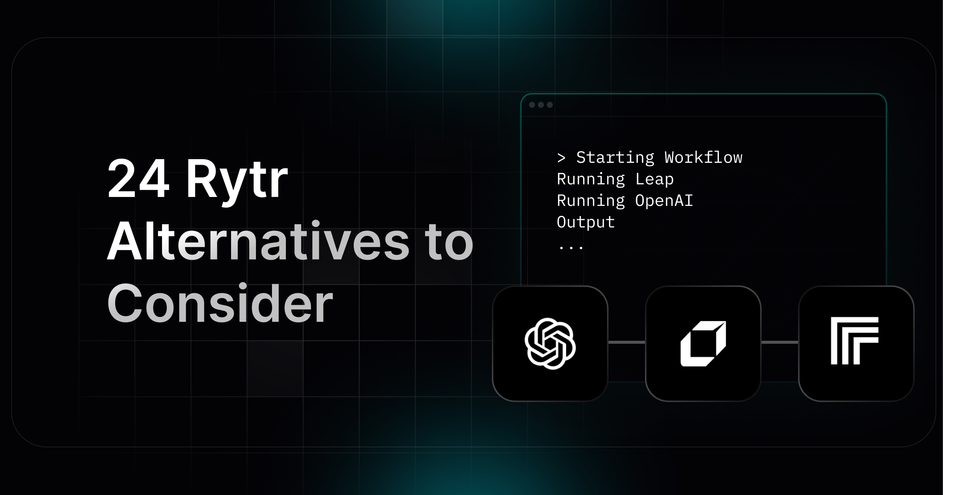How to Automate Content Creation for Increased Productivity in 2024
Increase your productivity by knowing how to automate content creation tasks. This guide will show you practical steps to simplify the process.

If you're looking to streamline your content creation process and boost productivity, automating content creation is the way to go. The benefits are many, including increased efficiency, reduced costs and higher-quality content. It's crucial to remember that automation doesn't mean eliminating the human touch altogether. It's all about finding the right balance between automation and manual input to create a winning content strategy. We're going to break down every stage of content creation to help you integrate automation, from content ideation to production and distribution. Let's get started!

What Is Content Automation?

The Role of AI Technology in Content Automation
AI technology plays a critical role in content automation by enabling machines to perform tasks typically requiring human intelligence. AI tools can automate the creation of content by generating readable text, editing content, optimizing images, and distributing articles.
Understanding Human Language
Natural language processing (NLP) technologies, a subset of AI, are used to understand, interpret, and generate human language content.
Enhancing Writing Tasks with NLP Automation
NLP capabilities can be used to automate various writing tasks, such as generating social media posts, summarizing content, or rewriting text. AI tools can also optimize images and videos, automate translations, or manage content distribution across different digital channels.
Content Creation Automation Tools
There are various tools and software available to automate content creation, including:
Content Creation Platforms
These platforms use templates and AI tools to generate SEO-optimized articles, blog posts, and other types of content based on user input.
Social Media Automation Tools
These tools can automate the creation and distribution of social media posts across different digital channels.
Email Automation Platforms
Email automation tools can generate and send personalized messages to a database of subscribers based on predefined rules.
Content Creation Automation Tools
There are various tools and software available to automate content creation, including:
Content Creation Platforms
These platforms use templates and AI tools to generate SEO-optimized articles, blog posts, and other types of content based on user input.
Social Media Automation Tools
These tools can automate the creation and distribution of social media posts across different digital channels.
Email Automation Platforms
Email automation tools can generate and send personalized messages to a database of subscribers based on predefined rules.

What Content Automation Does

Automated Content Creation for Topic Identification
Automatic content creation tools can assist in identifying topics by using natural language processing (NLP) technology. This technology, a subset of AI, enables computers to interpret written and spoken language. By examining related terms, content automation tools determine the most pertinent and effective topics.
Automated Content Generation
NLP also aids in creating automatic content. This technology is responsible for the familiar word prediction feature in most word processors. Advanced content generation programs generate original, understandable text using a list of keywords and phrases. Some tools can even produce sound files or images based solely on basic text inputs.
Automating Personalized Content
Personalizing content automation transcends content creation. Advanced automation tools such as Adobe Experience Manager use machine learning to consider additional factors, like the optimal time for readers to engage with content or how customers interact with content across all channels.
Enhancing User Engagement and Tracking
Tracking user engagement with content automation tools prevents overwhelming customers with excessive content. Scalable marketing efforts become more humanized. Engagement tracking considers key personal data points like time zone, gender, or age, enabling personalized engagement with customers on a large scale.
Improving Customer Experience
Automation enhances customer experience beyond personalization. Customers receive faster responses to queries or concerns and have more positive brand interactions, fostering deeper brand loyalty.
Social Media Coordination
Social media marketing involves more than publishing content. Tasks such as responding to messages, coordinating content across platforms, or tracking user behavior within trending topics can be automated. This saves time, increases online interaction, and fosters brand consistency.
Bulk Email Marketing
Diversify marketing efforts while saving time with automated email marketing. Target users based on specific demographics, boosting revenue by delivering content to interested users. Utilize AI tools and client data to send personalized, consistent communication to customers.
Proofreading and Editing
Using AI to automate content proofreading allows writers and editors to focus on specialized tasks. NLP technology scans text for grammatical errors, analyzes style and tone, and aligns content with brand voice, message, and goals.
Automating Lead Nurturing and Scoring
Implement automated lead-scoring algorithms in tandem with the sales team. Guide prospects more efficiently through sales and marketing funnels, enhancing internal processes’ efficiency and brand engagement.
Building and Segmenting Audiences
Automated AI functionality enables audience segmentation based on data analysis. Segment customers by engagement levels, age, or other demographics, or identify behavioral trends to develop tailored content.
Performance Analytics
Content automation eliminates guesswork in performance evaluation. Obtain precise data on every piece of content, measuring performance by engagement, sales, ROI, and other metrics. Be confident in content's effectiveness, supported by concrete performance metrics.
Related Reading
• Content At Scale Ai Detector
• Ai Content Creation
• Content Marketing Roi
• Social Media Automation
Why Is Content Automation Important?

Efficiency and Time Savings
Content automation significantly reduces the time and effort required for manual content creation and management. This allows content creators to allocate their time to higher-value tasks, such as strategy development and creative ideation.
Consistency and Quality
Automation helps maintain a consistent tone, style, and messaging across various content platforms, ensuring brand identity is upheld. It also reduces the likelihood of errors, resulting in higher-quality content.
Personalization and Improved User Experience
By leveraging AI and data analysis, content automation can create personalized content that is tailored to individual user preferences and behavior, leading to higher engagement and an improved user experience.
Scalability and Adaptability
Content automation allows businesses to quickly scale their content production efforts to meet increasing demands or to adapt to changing market trends, without a corresponding increase in resources or cost.
Data-Driven Decision Making
AI-driven content automation provides insights into content performance, enabling businesses to make data-informed decisions and adjustments to their content strategy, driving better results and a higher return on investment.
Competitive Advantage
Embracing content automation can provide businesses with a competitive edge, as they can create and distribute more relevant and engaging content at a faster pace than their competitors who rely solely on manual processes.
A Step-by-Step Guide on How to Automate Content Creation
Preparing for content automation
Evaluate your content needs and goals
Before diving into content automation, it’s important to conduct a thorough evaluation of your needs and goals. Start by identifying the type of content that resonates with your audience and aligns with your brand vision.
Understand your audience
Understanding your audience is pivotal to successful content automation. Develop detailed audience personas to capture the interests, needs, and behaviors of your target demographic.
Establish a content strategy
A well-thought-out strategy is the backbone of any content automation endeavor. This game plan should define the themes, topics, and types of content you’ll produce. It should also outline the frequency of publication and how it will be distributed across channels.
Choose the right automation tools
Selecting the right tools is critical to the success of your automated content creation process. Evaluate tools based on their ability to meet your specific content requirements, ease of integration with your current systems, and the user experience.
Crafting automated content
Define content templates and guidelines
The establishment of content templates and guidelines is an essential precursor to automation. These templates serve as a foundation upon which an AI Assistant can construct content.
Generate content ideas and outlines
Content ideas and outlines are the blueprints for your automated content. Utilizing tools like Leap AI, you can come up with content topics that are not only relevant to your audience but also optimized for search engines.
Create the content with an AI content creation tool
With the groundwork laid, creating content using an AI tool can begin. The tool can draft various kinds of content based on the input provided in the templates and outlines. While the AI does the heavy lifting, human oversight is crucial to refine the content and ensure that it is high-quality and relevant.
Optimize the content for SEO
Optimizing content for search engines is a key component of content creation. A top AI Assistant can suggest keywords, meta descriptions, and other SEO elements to enhance the visibility of your content.
Ensure quality and authenticity
The authenticity of content is vital to building trust with your audience. When content is generated by AI, some work must be put in to make it feel authentic and personal. Regular reviews and edits are absolutely necessary.
Incorporate multimedia elements
Multimedia elements such as images, videos, and infographics can significantly enhance the appeal and engagement of content. A top AI Assistant can assist in selecting relevant multimedia content.
Related Reading
• Ai Content Management
• How To Train Chatgpt To Write Like You
• Content Production Process
• Ai Powered Content Creation
• How To Make Ai Content Undetectable
• Content Marketing Workflow
• Content Scaling
• Content Planning For Social Media
• Content Automation
• Ai And Content Marketing
• Ai Content Optimization
• Content Marketing Automation
• Best Instagram Automation
• Content Workflow
• Automate Blog Posts
• Cost Effective Content Marketing
17 Best Content Automation Tools to Use in 2024

1. Leap
Leap offers custom AI automation without the need for coding, allowing for the integration of AI models like text, image, and audio processing with tools like OpenAI and Microsoft. It provides a wide range of automation possibilities such as:
- Document summarization
- Voice translation
- SEO automation
- AI call transcription
- AI avatar and asset generation
- Cold email automation
2. Semrush
Semrush is an all-in-one platform that helps improve online visibility and marketing performance. It offers tools for automating tasks such as rank tracking and site auditing, making content creation and analysis more efficient.
3. ImpactHero
ImpactHero aids in auditing content and recommends improvements by analyzing tracked pages through Google Tag Manager.
4. Buzzsumo
BuzzSumo automates content research and ideation, especially useful for social media, by generating popular topics related to keywords or industry.
5. ChatGPT
ChatGPT is an advanced AI chatbot suitable for generating content ideas or overcoming writer's block through conversational prompts.
6. ContentShake AI
Combining ChatGPT's chat capabilities with Semrush's SEO data, ContentShake AI streamlines content production processes.
7. Frase
Frase excels in creating SEO briefs through automating SERP research, which often requires hours of manual effort.
8. AI Social Content Generator
This tool automatically generates social media posts, including images, videos, and captions, by inputting topics and branding information.
9. Missinglettr
An all-in-one social media platform that simplifies social content creation and publishing, streamlining the campaign process.
10. Grammarly
Grammarly automates editing to enhance content quality, scanning for grammatical errors, inconsistencies in tone, plagiarism, and suggesting structural improvements.
11. ActiveCampaign
This platform automates email interactions through behavior triggers, boosting productivity in email marketing efforts.
12. ContentBot.ai
Offering diverse tools, ContentBot.ai is recommended for content automation, assisting in creating blog posts, social media captions, landing pages, and campaign management.
13. Hubspot
Ideal for small businesses, Hubspot provides a CRM platform with custom workflow automation, automated emails, and detailed customer interaction insights.
14. AdCreative
User-friendly and suitable for marketing and social media automation, AdCreative aids in e-commerce and startup marketing efforts by simplifying content creation and publishing.
15. Quark
Quark automates workflows, content creation, management, and publishing, with the ability to update content regularly and automatically adapt it for different devices.
16. Wordsmith
Specializing in short-form content, Wordsmith automates sales processes, generating personalized reports and articles of high quality.
17. Extensiv
Specifically designed for landing page automation, Extensiv streamlines the creation of optimized landing pages, facilitating multi-channel order fulfillment and integration with third-party tools.
Best Practices for Implementing Content Automation

Before you start automating content creation, it's essential to set clear goals and objectives. Ask yourself what you want to achieve through automation. Do you want to improve efficiency, increase consistency, or enhance personalization? By defining your objectives from the outset, you can ensure that your content automation efforts are aligned with your broader organizational goals.
Identifying Areas for Automation
Content production involves various tasks that could benefit from automation. Look for repetitive tasks or areas where automation can significantly improve the process. Content automation tools can help with content generation, curation, optimization, distribution, and management. By identifying the right opportunities for automation, you can streamline your content creation process and free up your team to focus on higher-value tasks.
Choosing the Right Tools and Technologies for Content Automation
Once you've identified the areas to automate, it's time to select the right tools and technologies for the job. Research different content automation tools available in the market and consider factors like compatibility with your existing systems, ease of use, scalability, and the ability to integrate with other tools or platforms. Choosing the right tools will ensure that your content automation efforts are effective and efficient.
Developing a Comprehensive Content Strategy
A content strategy serves as a roadmap for your content automation efforts. Outline the type of content you want to create, your target audience, the channels for distribution, and the desired outcomes. With a solid content strategy in place, you can ensure that your automated content creation aligns with your broader business objectives.
Prioritizing Personalization and Relevance
Content automation should prioritize personalization and relevance for your target audience. Leverage AI-driven tools to analyze user preferences and behavior and deliver personalized content that engages users and meets their needs. By focusing on personalization and relevance, you can ensure that your automated content resonates with your audience and drives results.
Maintaining Quality Control in Content Automation
Automated content creation doesn’t mean compromising on quality. Implement quality control measures to ensure that your automated content meets your organization's standards for quality, consistency, and accuracy. Establish a review process that involves human input to verify and fine-tune the content created by automated tools.
Monitoring Performance and Optimizing Content Automation
Regularly monitor the performance of your automated content creation efforts. Use data-driven insights to make improvements and optimize your content strategy, tools, or processes as needed. By tracking key performance indicators (KPIs), you can ensure that your content automation efforts are delivering the desired outcomes.
Training Your Team for Content Automation
It's essential to train your team to use content automation tools effectively. Ensure that your team understands the goals of implementing automation and provide training and support to help them adapt to the new processes. By investing in training, you can maximize the benefits of content automation and empower your team to create high-quality content more efficiently.
Continuously Iterating and Improving Your Content Automation Process
Content automation is an ongoing process that requires continuous improvement. Regularly review your automation efforts, gather feedback from your team, and make adjustments as needed to optimize the system and achieve your goals. By staying agile and open to change, you can ensure that your content automation efforts remain effective and aligned with your objectives.
Related Reading
- Midjourney Alternatives
- Ai Content Creation Tools
- Best Linkedin Automation Tools
- Social Media Automation Tools
- Content Automation Tools
- Writesonic Alternative
- Copy Ai Alternatives
- Jasper Ai Alternative
- Rytr Alternatives
- Wordtune Alternatives
- Ai Content Generator Api
- Content Automation Services
- Frase Alternative
Create Game Changing Automations Today With Leap’s AI Workflows

Automating content creation can significantly improve efficiency, productivity, and creativity by leveraging AI models and smart integrations. Leap Workflows is a powerful tool that helps you automate your work using the power of AI. With partnerships with leading platforms like Zapier, Vercel, and more, Leap allows you to create sophisticated AI automations without any coding skills.
You can connect your favorite tools with the best-in-class AI text, image, and audio models, supercharging your workflows effortlessly. Whether you need to summarize documents, translate voice messages, transcribe calls, generate AI avatars and assets, automate SEO processes, or streamline cold email creation and sending, Leap Workflows has got you covered.
The possibilities for automation are limitless with Leap Workflows, so why not try it out for free today?




